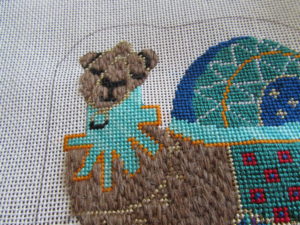
This camel is from a vintage narivity set by Deluxe Designs I bought partially stitched. The original stitcher was quite inventive in her choice of threads and often in her choice of stitches, as is the case here.
In real life Dromedairy camels (one hump) have a mixture of longish and short fur. Because the hump has longer fur and is usually covered with a blanket or saddle, as is the case here, often stitchers will use more furry threads throughout. This gives the camels a lovely rustic look.
In stitching this camel you see many techniques you may want to incorporate into your own figures:
Fuzzy Thread: A good choice for camels is Rainbow Gallery’s Alpaca. It comes in two sizes Alpaca 18 and Alpaca Petite. I find Alpaca 18 a bit thick for 18 mesh but it works beautifully on bigger mesh. Most of the colors in this thread are the natural colors of Alpaca fur. Because it is undyed, the thread has a lovely natural variation within each strand. This contributes greatly to the rustic texture of the camel.
Once stitched, Alpaca can be brushed or left unbrushed. It was not brUsHed here. While still furry, it allows the stitches to be seen clearly.
Irregular Upright Gobelin for Stitching: This stitch automatically creates a rustic look because it is not stitched in regular rows. Stitches can range over two to five threads. Except where stitches meet something else, no two adjacent stitches share beginnings or endings. This is essential to the rustic look. You can have short diagOnal runs of up to five stitches that descend or ascend in a diagonal line,. At the beginning or end of these runs there should be a change in stitch length of two threads.
This stitch is great because it is difficult to mess up. Start in the middle of your area and make rows, diaginal rows, or groups of stitches. Once that first group is complete, make other group or rows around it. The stitched area will grow organically.
It is important to understand how this stich differs from other types of Gobelin.
- It is not like EncroacheD Gobelin because one row does not begin or end inside adjacent rows of stitches
- It is not like Long & Short because you do not establish the long-short alternating pattern and fill in.
- It is not like Brick because the stitches don’t alternare in a brick-like fashion.
- It is not like Bargello because it does not follow a regular step pattern.
In most of the above stitches, the sttch length remains constant that, importantly, is not the case here.
Long eyelashes: Like many other members of this family, camels have long eyelashes. If you have space, making longer eyelashes with additional Tent Stitches or short Slanted Gobelins adds a touch of realistic whimsy.
Prominent nose & mouth: A camel’s features often feel a bit too large for its head. A great way to achieve this is to make them more prominent in your stitching. The original stitcher did this here by stitching the mouth and nose with black pearl cotton in Tent and Reverse Tent. The smoother dark thread stands out against the lighter fur.
On Thursday find instructions for stitching donkeys. Next Monday, I’ll finish the series with elephants.
About Janet M Perry
Janet Perry is the Internet's leading authority on needlepoint. She designs, teaches and writes, getting raves from her fans for her innovative techniques, extensive knowledge and generous teaching style. A leading writer of stitch guides, she blogs here and lives on an island in the northeast corner of the SF Bay with her family

Leave a Reply